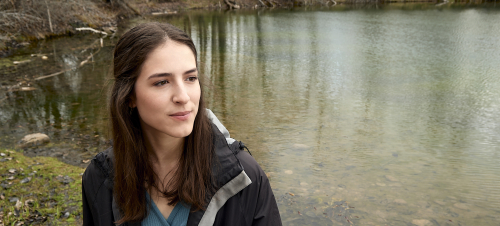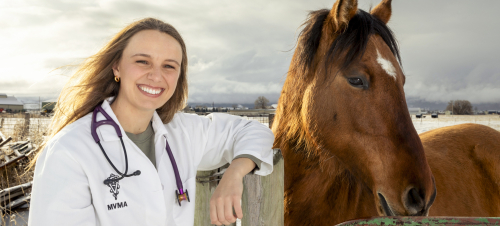Teaching and Learning
Our faculty, staff and students are the backbone of MSU's efforts in agricultural education. This year, they continued their long history of excellence.
Montana State’s Pilar Santos earns one of the nation’s top graduate student fellowships

Pilar Santos. MSU photo by Kelly Gorham.
By Reagan Cotton, MSU News Service
May 8, 2024
A recent graduate of Montana State University’s Department of Microbiology and Cell Biology will continue environmental research begun during her undergraduate career with the support of a prestigious fellowship from the National Science Foundation.
Pilar Santos received an award through the NSF’s Graduate Research Fellowship Program, which is designed to support graduate students in broad array of scientific programs. Founded in 1951, it is one of the oldest graduate fellowship programs in the nation.
Santos, who is originally from Helena, finished her undergraduate studies in environmental health in December 2023, graduating a semester early. She was encouraged to apply for the GRFP by her adviser, Mari Eggers, an associate research professor in the College of Agriculture’s Department of Microbiology and Cell Biology.
“Getting this fellowship helped a lot with getting to choose where I wanted to go to graduate school,” said Santos, who will continue her studies at the University of Washington. “I was struggling to find funding, and this gave me an extra push and opened up a lot of new opportunities.”
Read more about Pilar Santos' work here.
Montana State veterinary student eyes goal of serving her home state

Morgan Radtke. MSU photo by Marcus "Doc" Cravens.
By Reagan Cotton, MSU News Service
March 20, 2024
Morgan Radtke thought she wanted to be a doctor who treated humans, but the COVID-19 pandemic reduced the number of spaces for clinical shadowing in hospitals, leading her instead to intern in a veterinary clinic. The experience changed her life, reorienting her career ambitions, and now Radtke is a first-year student in the WIMU Regional Program in Veterinary Medicine at Montana State University.
Radtke was working toward a bachelor’s degree in exercise science at the University of Montana, where she also competed on the track and field team, when the pandemic began in 2020. Without an opportunity for hospital experience, she found herself back home in Drummond, working and learning in a veterinarian’s office.
“I really loved it. The practitioners there were super welcoming to me and made it a good experience. I realized I could see myself doing this,” said Radtke. “So, I applied to seven vet schools and was lucky enough to get into the WIMU program.”
Radtke completed her exercise science degree and began a master’s in business administration in the years that followed, all while taking advantage of an additional year of athletic eligibility awarded by the NCAA to make up for seasons canceled by COVID. This fall, she formally began her veterinary studies at MSU.
Learn more about the WIMU program here.
Montana State landscape design students integrate wildfire resilience and drought tolerance into novel project

A digital landscape rendering by MSU student Berry Berryman.
By Reagan Cotton, MSU News Service
August 29, 2023
The Bridger Foothills fire in 2020 burned around 8,000 acres along the south end of the Bridger Mountains, including more than 30 homes. Several residential neighborhoods were less than 2 miles from the wildfire. Since an ember can travel up to 4 miles ahead of an active wildfire front, those neighborhoods were well within range.
That reality, along with drought in the American West, was the focus of a unique project undertaken by Montana State University landscape design students this spring. The students, under the direction of adjunct professor Sonya Gimon, worked with a pair of Bozeman homeowners to integrate fire resilience and drought tolerance into new landscape design suggestions.
The course is part of the landscape design option within MSU’s environmental horticulture program, which is housed in the College of Agriculture’s Department of Plant Sciences and Plant Pathology. And while both drought and wildfire are well-known to Montana residents, Gimon said that, as with other climate impacts, the exciting challenge for landscape architects and designers is to balance various considerations to create resilient landscapes.
“Most of my professional experience is in larger public projects that respond to a combination of climate impacts, such as sea level rise, urban heat island effect and biodiversity loss, so it was really interesting to see how students were able to apply a similar layered approach to design in the local residential context,” said Gimon.
Read more about MSU's environmental horticulture program here.
Montana State doctoral student reflects on simulated Mars mission in Hawaii

Maria Fernandes-Martins on a simulated Mars mission on the Big Island of Hawai'i.
By Reagan Cotton, MSU News Service
August 14, 2023
In the small town in Brazil where Maria Fernandes-Martins grew up, man-made light was scarce enough that she was afforded a dazzling view of the night skies. That was all it took to set Fernandes-Martins, now a doctoral candidate at Montana State University, on a cosmic path.
“Space has always been on my mind. I admired it growing up because it was always there,” she said. “Of course, I dreamed of being an astronaut, but haven’t we all dreamed of that?”
Fernandes-Martins, who conducts microbiology research in the lab of Eric Boyd in MSU’s Department of Microbiology and Cell Biology, got to experience astronaut life in more detail than most people during a recent mission through the Hawaii Space Exploration Analog and Simulation program, or HI-SEAS. She traveled to Hawaii’s Big Island in May to undertake a weeklong simulated Mars mission on the flank of the Mauna Loa volcano at an elevation of around 8,000 feet. It is one of the closest proxies on Earth to the topography and landscape of the red planet.
Read more about Maria Fernandes-Martins' simulated Mars mission here.
